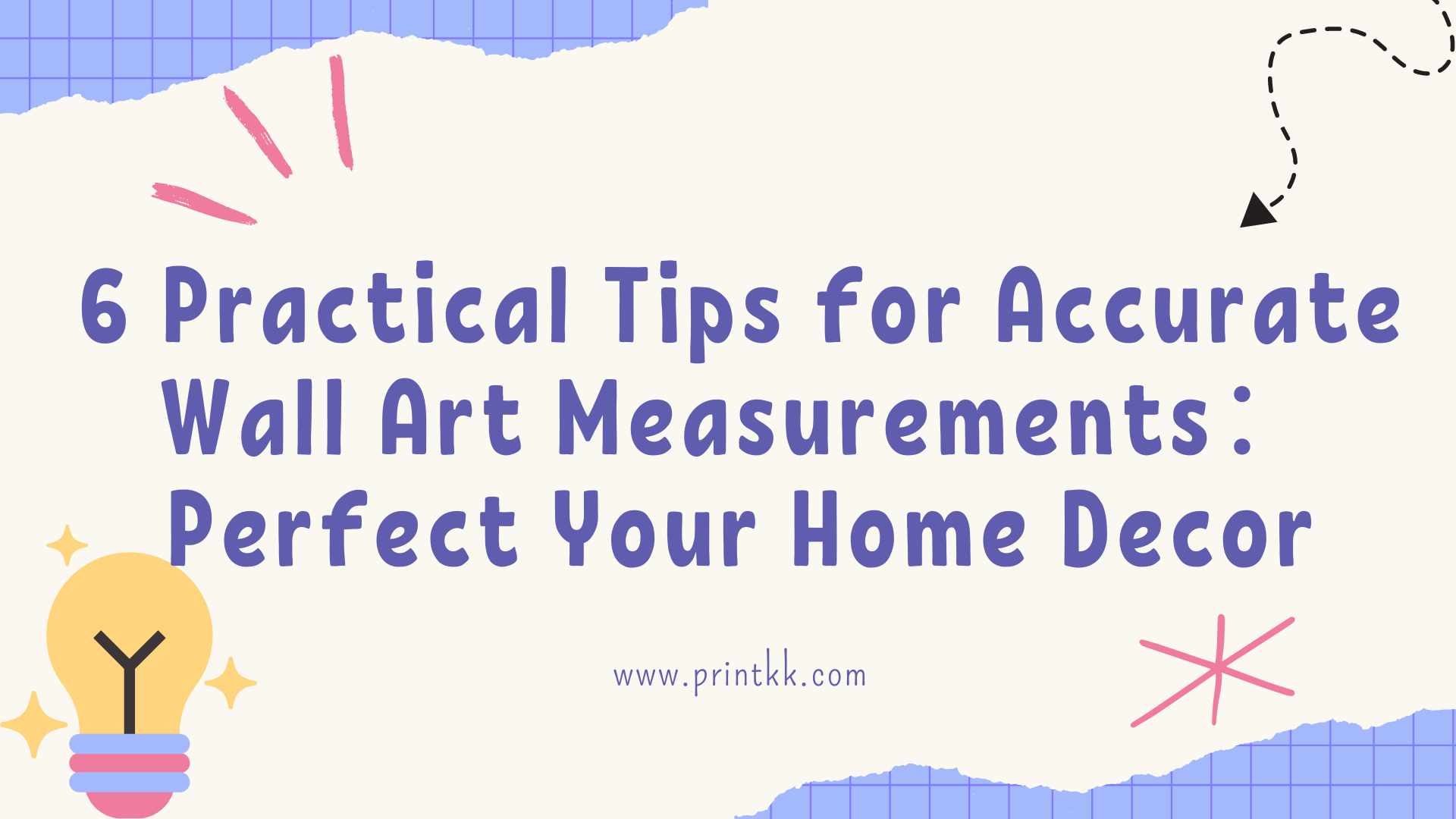
Transform your living space with perfectly placed wall art! Discover six practical tips for measuring and hanging art that will elevate your home decor. Whether you're an experienced designer or just starting, these easy-to-follow guidelines will help you achieve a balanced and visually appealing display, turning any room into a stylish haven.
What Is the Average Size of Wall Art?
Common wall art sizes are generally categorized as small, medium, and large. Small pieces typically range from 8 x 10 inches to 12 x 16 inches, making them ideal for smaller spaces or as part of a gallery wall.
Medium-sized art, which ranges from 16 x 20 inches to 24 x 36 inches, can serve as focal points in rooms without overwhelming the space. These sizes are versatile and can work well above furniture or in narrow wall areas.
Large wall art, often measuring 30 x 40 inches or larger, is perfect for making a bold statement. These pieces are well-suited for spacious areas like living rooms, dining rooms, or office lobbies. For example, a 36 x 48-inch piece can become a central feature above a sofa or in a hallway, adding visual interest and filling the space proportionately.

Print on Demand Square Canvas Prints Wall Art - Wall Art - PrintKK
Why Measure the Size of Your Wall Art?
Measuring the size of your wall art is crucial for achieving a balanced and aesthetically pleasing decor. When you know the exact dimensions of your artwork, you can ensure it fits perfectly within the designated space without overwhelming or underwhelming the room.
Proper measurements also help in planning the layout of multiple pieces. When creating a gallery wall, knowing the sizes of each artwork allows you to arrange them in a cohesive and visually appealing manner.
You also need to know that measuring your wall art will help you choose the appropriate frame and mounting hardware. The wrong hardware can result in an insufficiently secure and unstable artwork. By knowing the dimensions, you can choose the right parts to support your artwork to prevent it from getting damaged.
How to Determine the Dimensions of Wall Art for an Area?
When aiming to improve your area with artwork, start by gauging the width of the wall section where you plan to hang the piece. A general rule of thumb is that the artwork should occupy approximately two-thirds to three-quarters of that space. For example, if your wall measures 60 inches in width, target artwork that covers approximately 40 to 45 inches in width.
Next, take into account the height of the ceiling and the furnishings in the room. The bottom edge of the artwork should hang approximately 8 to 10 inches above any furniture like a sofa or a console table. When displaying art in a hallway or on an empty wall, the center of the artwork should ideally be at eye level, typically about 57 to 60 inches above the floor.
6 Practical Tips Measuring Wall Art
Understand Your Space
Grasping the measurements of your wall area is the initial step in choosing correctly sized wall art. Measure the width and height of the wall where you intend to hang your artwork. This helps you determine the maximum dimensions your artwork should be.
For example, in a hallway, you might opt for a tall and narrow art piece, while a wide tapestry wall hanging could be perfect for the wall above your sofa. Knowing the size of your space ensures that your art will fit appropriately and enhance the room's overall aesthetic without overwhelming it.
Consider also the placement of other elements in the room, such as furniture and windows, which can influence the ideal size and positioning of your wall art.
For instance, if you have a low-profile sofa, a vertically oriented piece might add height and balance to the space. Conversely, a horizontal piece can create a sense of width and openness.
.jpg)
Consider the Eye Level
Hanging your wall art at eye level creates a more engaging and visually comfortable display. Typically, the center of the artwork should be positioned approximately 57 to 60 inches above the floor. This standard ensures that the art is easily viewable and not too high or too low.
For a gallery wall, arrange the pieces so that the collective center is at eye level. This tip works well in living rooms, hallways, and other spaces where you want the art to be a focal point.
When placing art above furniture, ensure there is a 6- to 8-inch space between the top of the furniture and the bottom of the artwork. This spacing creates a cohesive look and prevents the artwork from appearing disconnected from the room's furnishings..jpg)
Use the Right Tools
Using the right tools simplifies the measuring and hanging process, making it more precise. A tape measure, level, and pencil are essential for getting precise measurements and ensuring your art hangs straight. Use the tape measure to determine the exact placement and the level to check alignment. Lightly mark the wall with a pencil where the nails or hooks will go, so you can make adjustments if necessary.
For more substantial items, think about utilizing wall anchors to enhance stability. If you are hanging a very large piece or multiple pieces in a grid pattern, a laser level can be especially useful to ensure everything is perfectly aligned.Appropriate tools not only streamline the process but also aid in avoiding damage to your walls and artwork.
Plan Your Layout
Before you start hammering nails into the wall, plan your layout carefully. Lay your artwork on the floor in front of the wall to visualize different arrangements. As another option, create paper mock-ups that match the dimensions of your artwork and affix them to the wall to test out different spacing and placement arrangements.
For instance, when assembling a gallery wall, begin by placing the largest artwork in the center and expand outward from there.This method helps maintain symmetry and balance, ensuring that the collection looks well-organized rather than haphazard.
.jpg)
Scale and Proportion
Choosing art that is appropriately scaled to your wall is crucial for a harmonious look. Large walls can handle bigger pieces or a curated collection of smaller artworks, whereas smaller walls are more appropriate for modest-sized art. For example, a large abstract painting can serve as a statement piece in a spacious living room, while a set of small prints might be perfect for a cozy reading nook.
It's important to consider the scale of the artwork relative to the walls and surrounding furniture to maintain visual balance. A piece that is too small might appear lost on a large wall, whereas one that is too large can dominate and overwhelm a smaller space. For instance, over a large sectional sofa, a series of smaller works arranged in a grid can provide the same visual impact as one large piece, while adding variety and interest.
Groupings and Spacing
When hanging multiple pieces, whether as part of a gallery wall or a set, maintain consistent spacing between them. Typically, 2 to 3 inches between each piece is ideal. This spacing keeps the arrangement unified and prevents it from looking cluttered. For instance, if you have a series of wall sound absorbing panels, keep the distance between each section equal.
Groupings should also be considered as one unit, with the overall dimensions fitting well within the wall space. Proper spacing and grouping techniques help in achieving a polished look. You can mix heavier-looking, more visually dominant pieces with lighter, simpler pieces to balance the overall composition. This method guarantees that no individual piece overshadows the others, resulting in a cohesive and aesthetically pleasing arrangement.
.jpg)
Custom Wall Sound Absorbing Panels 10pcs - Print on Demand Fulfillment - PrintKK
How to Choose the Right Size for Wall Art?
Selecting the correct size for wall art starts with grasping the measurements of your wall and the proportion of your area. Take the width and height of the wall where you intend to display your artwork. A general rule of thumb is that the artwork should take up 60-75% of the wall space, ensuring it neither overwhelms nor underwhelms the room.
The size of your furniture and other decor elements also plays a crucial role in determining the right size for your wall art. When displaying art above furniture like a sofa or console table, strive for the artwork to be approximately two-thirds the width of the furniture. This proportion ensures the art and furniture work together harmoniously.
How Do You Know if Wall Art Is Too Big for a Room?
Determining if wall art is too big for a room starts with measuring the wall space and considering the room's overall size. A common guideline is that wall art should occupy 60-75% of the available wall space. For instance, if you have a blank wall that is 10 feet wide, your artwork should be between 6 and 7.5 feet wide to achieve a balanced look. This recommendation helps ensure that the art complements the room without overpowering it.
Another important factor to consider is the furniture and other decorative elements in the room. If the art dwarfs the furniture or disrupts the visual flow, it might be too large. For example, when positioning art above a sofa, it should be roughly two-thirds the width of the sofa to achieve a harmonious appearance. Too large a piece can make the room feel cramped and cluttered, while a well-sized piece complements the space, adding to the overall aesthetic appeal.
Conclusion
Learn six practical tips for measuring walls and take your home decorating skills to the next level. Whether it's using the right tools or planning your layout ahead of time, it can help you create a more perfect living space. These practical and simple methods can help you achieve a balanced visual display in your home and complete a cohesive decor design.
Remember, choosing the perfect size for wall art requires considering the room's existing decor and overall style. Take the time to explore these ways to measure wall art and give your room's style more depth.
FAQs
What is the standard wall art size?
Standard wall art sizes can vary, but typical dimensions include 16x20 inches, 18x24 inches, and 24x36 inches. These sizes are generally suitable for most spaces and are adaptable to various design styles.
What is the best proportion for wall art?
The ideal proportion for wall art is typically 60-75% of the width of the furniture below it. For instance, if your sofa is 80 inches wide, your artwork should be between 48 and 60 inches wide.
What size wall art is most popular?
The most popular size for wall art typically ranges from 24x36 inches to 36x48 inches. They provide a balanced aesthetic that enhances any room's visual appeal.
Can wall art be larger than the furniture?
Indeed, wall art can be larger than the furniture to make a bold statement. Also keep in mind that you also need to consider the overall design and scale of the room to achieve a unified look.










 Global Shipping
Global Shipping




 Made in USA
Made in USA
























